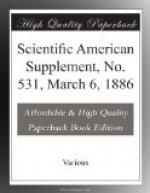Sufficient has been advanced to warrant the additional assertion that we are here everywhere surrounded by this incomparable mineral, that it is brought to the surface from its deposits deep in the earth by the natural process in mining, and is only exceeded in quantity by the coal itself. Taking a columnar section of our coal field, and computing the thickness of each shale stratum, we have from twenty-five to sixty feet in thickness of this metal-bearing substance, which averages over twenty-five per cent. of the whole in quantity in metal.
It is readily apparent that the only task now before us is the reduction of the ore and the extraction of the metal. Can this be done? We answer, it has been done. The egg has stood on end—the new world has been sighted. All that now remains is to repeat the operation and extend the process. Cheap aluminum will revolutionize industry, travel, comfort, and indulgence, transforming the present into an even greater civilization. Let us see.
We have seen the discovery of the mere chemical existence of the metal, we have stood by the birth of the first white globule or bead by Wohler, in 1846, and witnesssed its introduction as a manufactured product in 1855, since which time, by the alteration and cheapening of one process after another, it has fallen in price from thirty-two dollars per pound in 1855 to fifteen dollars per pound in 1885. Thirty years of persistent labor at smelting have increased the quantity over a thousandfold and reduced the cost upward of fifty per cent.
All these processes involve the application of heat—a mere question of the appliances. The electric currents of Berzelius and Oersted, the crucible of Wohler, the closed furnaces and the hydrogen gas of the French manufacturers and the Bessemer converter apparatus of Thompson, all indicate one direction. This metal can be made to abandon its bed in the earth and the rock at the will of man. During the past year, the Messrs. Cowles, of Cleveland, by their electric smelting process, claim to have made it possible to reduce the price of the metal to below four dollars per pound; and there is now erecting at Lockport, New York, a plant involving one million of capital for the purpose.
Turning from the employment of the expensive reducing agents to the simple and sole application of heat, we are unwilling to believe that we do not here possess in eminence both the mineral and the medium of its reduction. Whether the electric or the reverberatory or the converter furnace system be employed, it is surely possible to produce the result.
To enter into consideration of the details of these constructions would involve more time than is permitted us on this occasion. They are very interesting. We come again naturally to the limitless consideration of powdered fuel, concerning which certain conclusions have been reached. In the dissociation of water into its hydrogen and oxygen, with the mingled carbon in a powdered state, we undoubtedly possess the elements of combustion that are unexcelled on earth, a heat-producing combination that in both activity and power leaves little to be desired this side of the production of the electric force and heat directly from the carbon without the intermediary of boilers, engines, dynamos, and furnaces.




